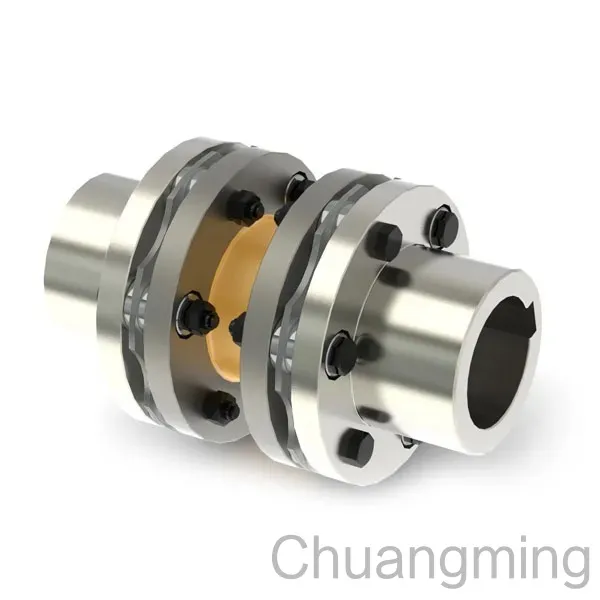Copyright © 2025 Chuangming Coupling (Jiangsu) Co.,Ltd.
Diaphragm coupling bolts wear and produce abnormal noise
2025-08-01
Release time: 2025-08-01 15:00:54
Information summary: Excessive axial offset or excessive deflection angle of the diaphragm coupling will also cause oscillation and abnormal noise when the equipment is running; when there is a difference in the speed of the automatic end and the forced end, it will also cause equipment operation problems. Vibration and abnormal noise, the motor's speed code disk is malfunctioning, causing the motor's speed to be fast and slow, causing the diaphragm coupling to produce abnormal noise.
If the axial offset or deflection angle of the diaphragm coupling is too large, it will also cause oscillation and abnormal noise when the equipment is running; when there is a difference in the speed of the automatic end and the forced end, it will also cause oscillation and abnormal noise when the equipment is running. If there is a noise, there is a problem with the speed code disk of the motor, causing the motor speed to be fast and slow, causing the diaphragm coupling to make abnormal noise. The diaphragm is subjected to a large axial force, which causes the twisted holes or twisted bolts to wear.
Because the electrical function accelerates the shaft connection of the working machine, the shape of the shaft hole, the connection form and the size of the connected shaft, according to the cylindrical and conical shaft depth, different types and different forms of non-metallic diaphragm couplings are customized in the design When designing the series, the size of the transmitted torque is based on the customization of the diaphragm coupling and the strength of the hub. The range of the shaft hole of the non-metallic diaphragm coupling and the length of the shaft hole are also used.

Each specification requires a length of shaft hole. In the standards of different diaphragm couplings, there are errors in the length of the shaft hole of the components of each specification of diaphragm couplings. The changes in the shaft hole of each specification in the diaphragm coupling qualification standards are related to the length of the shaft hole. When the diaphragm coupling standard is converted into a standard, a variety of shaft hole lengths are also added. This is required to be considered. Transformation.
Appropriate tools must be selected to disassemble the bolts, because the stress-bearing surface of the bolt's external hexagon or internal hexagon has been slipped and damaged, making disassembly difficult. For bolts that have been corroded or have a lot of grease, solvent is often sprayed on the connection between the bolt and the nut to allow the solvent to penetrate into the threads, which will make them easier to disassemble. If the bolt cannot be disassembled, heating can be used to increase the gap between the nut and the bolt, and the rust will fall off easily, making it easier to disassemble the bolt.
Release time: 2025-08-01 15:00:54
Information summary: Excessive axial offset or excessive deflection angle of the diaphragm coupling will also cause oscillation and abnormal noise when the equipment is running; when there is a difference in the speed of the automatic end and the forced end, it will also cause equipment operation problems. Vibration and abnormal noise, the motor's speed code disk is malfunctioning, causing the motor's speed to be fast and slow, causing the diaphragm coupling to produce abnormal noise.
If the axial offset or deflection angle of the diaphragm coupling is too large, it will also cause oscillation and abnormal noise when the equipment is running; when there is a difference in the speed of the automatic end and the forced end, it will also cause oscillation and abnormal noise when the equipment is running. If there is a noise, there is a problem with the speed code disk of the motor, causing the motor speed to be fast and slow, causing the diaphragm coupling to make abnormal noise. The diaphragm is subjected to a large axial force, which causes the twisted holes or twisted bolts to wear.
Because the electrical function accelerates the shaft connection of the working machine, the shape of the shaft hole, the connection form and the size of the connected shaft, according to the cylindrical and conical shaft depth, different types and different forms of non-metallic diaphragm couplings are customized in the design When designing the series, the size of the transmitted torque is based on the customization of the diaphragm coupling and the strength of the hub. The range of the shaft hole of the non-metallic diaphragm coupling and the length of the shaft hole are also used.

Each specification requires a length of shaft hole. In the standards of different diaphragm couplings, there are errors in the length of the shaft hole of the components of each specification of diaphragm couplings. The changes in the shaft hole of each specification in the diaphragm coupling qualification standards are related to the length of the shaft hole. When the diaphragm coupling standard is converted into a standard, a variety of shaft hole lengths are also added. This is required to be considered. Transformation.
Appropriate tools must be selected to disassemble the bolts, because the stress-bearing surface of the bolt's external hexagon or internal hexagon has been slipped and damaged, making disassembly difficult. For bolts that have been corroded or have a lot of grease, solvent is often sprayed on the connection between the bolt and the nut to allow the solvent to penetrate into the threads, which will make them easier to disassemble. If the bolt cannot be disassembled, heating can be used to increase the gap between the nut and the bolt, and the rust will fall off easily, making it easier to disassemble the bolt.